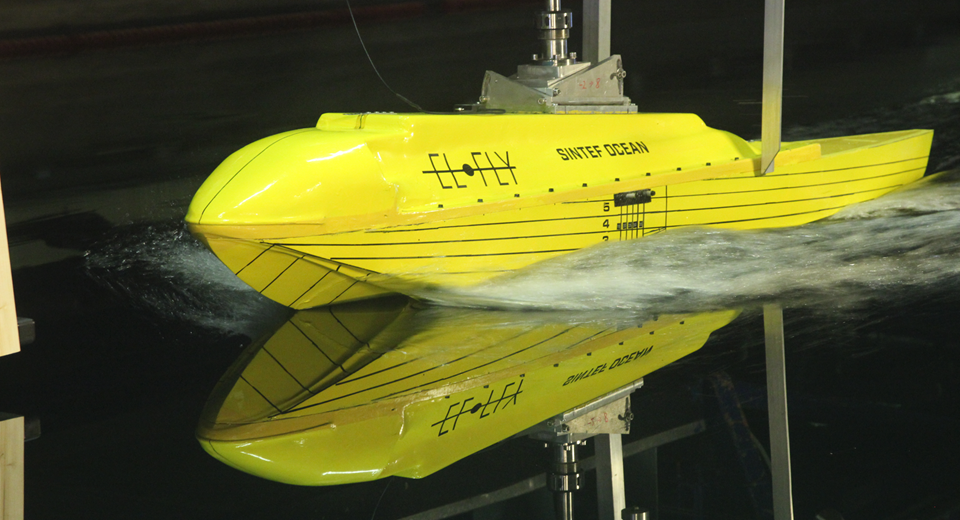Elfly project will link Norwegian cities with electric seaplanes
Norway has a lot of coastline and many fjords, but not much in the way of flat, open ground on which to build runways. That’s where the Elfly project comes in, as it’s developing a short-haul electric seaplane that can take off and land in city harbours.
The basic idea is that instead of having to traipse to and from airports located out in the countryside – which would be difficult to build – passengers will simply travel between sea terminals in city centers, from which fleets of Elfly’s Byfly seaplanes will be based. Because the aircraft will be equipped with relatively quiet-running electric motors, engine noise shouldn’t be a problem.
The nine-passenger Byfly can in fact be described as a flying boat, in that it will float mainly on its boat-like hull instead of a set of pontoons. That hull is currently in development at Norway’s SINTEF research institute, where scale models are being towed across the surface of a 260-meter (853-ft) water tank.
SINTEF
It should be noted that there will be small pontoons at the ends of the wings, to stabilize the plane when taking off and landing. Additionally, retractable wheels will allow it to use traditional runways when necessary.
Two 825-kW wing-mounted pusher-prop motors will take the Byfly up to a top speed of 300 km/h (186 mph). They will be powered by a lithium battery bank, which should deliver an operational range of up to 250 km (155 miles) per charge – that figure is likely to increase as battery technology advances. Depending on factors such as the distance of the flight, the cockpit can be configured for either one or two pilots.
Plans call for a full-scale prototype to be operational within three years, thanks in part to NOK 16 million (about US$1,650,070) in funding from the Research Council of Norway. It is hoped that 15 to 20 of the aircraft will be in commercial use by 2030.
“The goal is to be able to provide flexible mobility in Norway, with zero emissions and significantly reduced noise pollution, and also develop new, sustainable business models,” said Elfly CEO Eric Lithun.
For now, you can see a one-tenth scale model in flight, in the video below.
Electric seaplane, Byfly (X10), Norwegian flying boat concept
Norway has a lot of coastline and many fjords, but not much in the way of flat, open ground on which to build runways. That’s where the Elfly project comes in, as it’s developing a short-haul electric seaplane that can take off and land in city harbours.
The basic idea is that instead of having to traipse to and from airports located out in the countryside – which would be difficult to build – passengers will simply travel between sea terminals in city centers, from which fleets of Elfly’s Byfly seaplanes will be based. Because the aircraft will be equipped with relatively quiet-running electric motors, engine noise shouldn’t be a problem.
The nine-passenger Byfly can in fact be described as a flying boat, in that it will float mainly on its boat-like hull instead of a set of pontoons. That hull is currently in development at Norway’s SINTEF research institute, where scale models are being towed across the surface of a 260-meter (853-ft) water tank.

SINTEF
It should be noted that there will be small pontoons at the ends of the wings, to stabilize the plane when taking off and landing. Additionally, retractable wheels will allow it to use traditional runways when necessary.
Two 825-kW wing-mounted pusher-prop motors will take the Byfly up to a top speed of 300 km/h (186 mph). They will be powered by a lithium battery bank, which should deliver an operational range of up to 250 km (155 miles) per charge – that figure is likely to increase as battery technology advances. Depending on factors such as the distance of the flight, the cockpit can be configured for either one or two pilots.
Plans call for a full-scale prototype to be operational within three years, thanks in part to NOK 16 million (about US$1,650,070) in funding from the Research Council of Norway. It is hoped that 15 to 20 of the aircraft will be in commercial use by 2030.
“The goal is to be able to provide flexible mobility in Norway, with zero emissions and significantly reduced noise pollution, and also develop new, sustainable business models,” said Elfly CEO Eric Lithun.
For now, you can see a one-tenth scale model in flight, in the video below.
Electric seaplane, Byfly (X10), Norwegian flying boat concept
